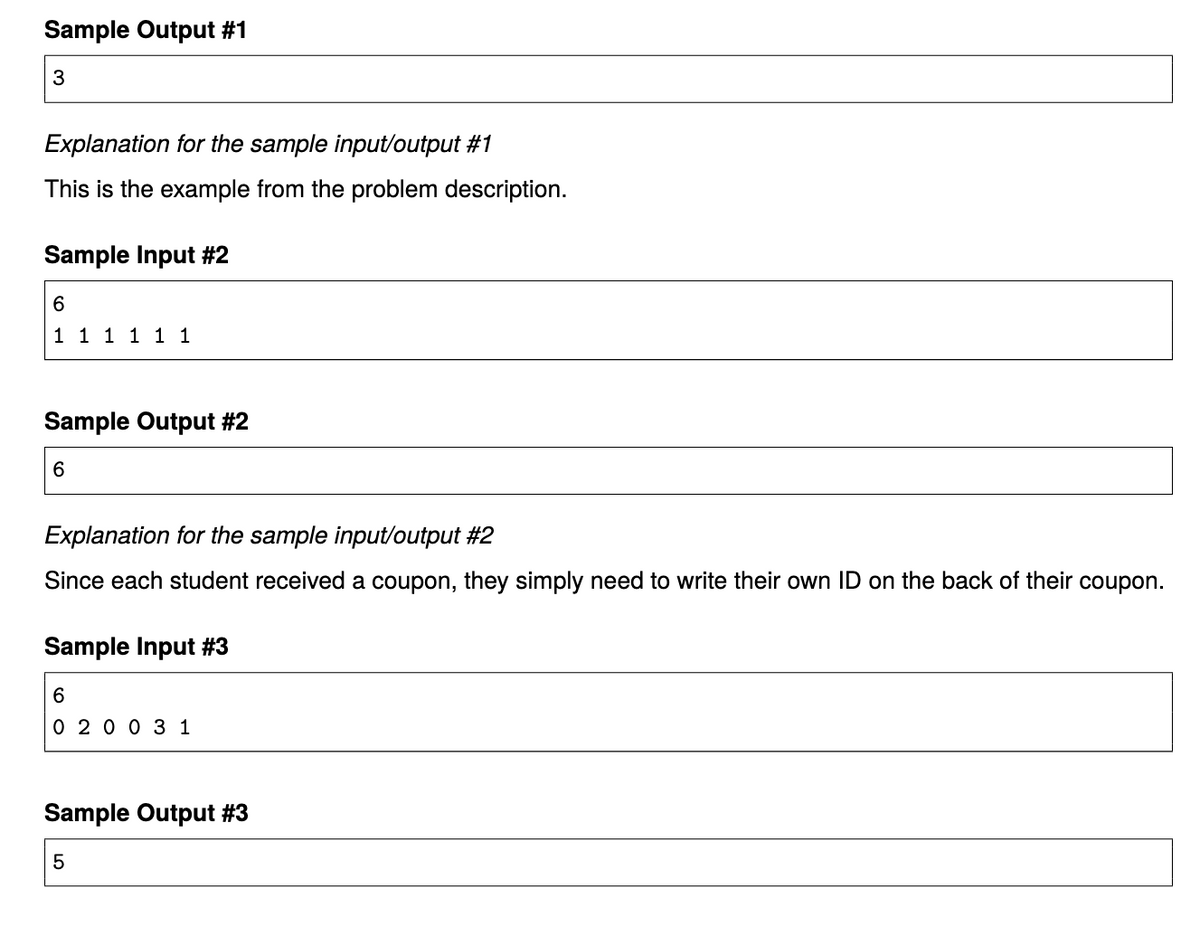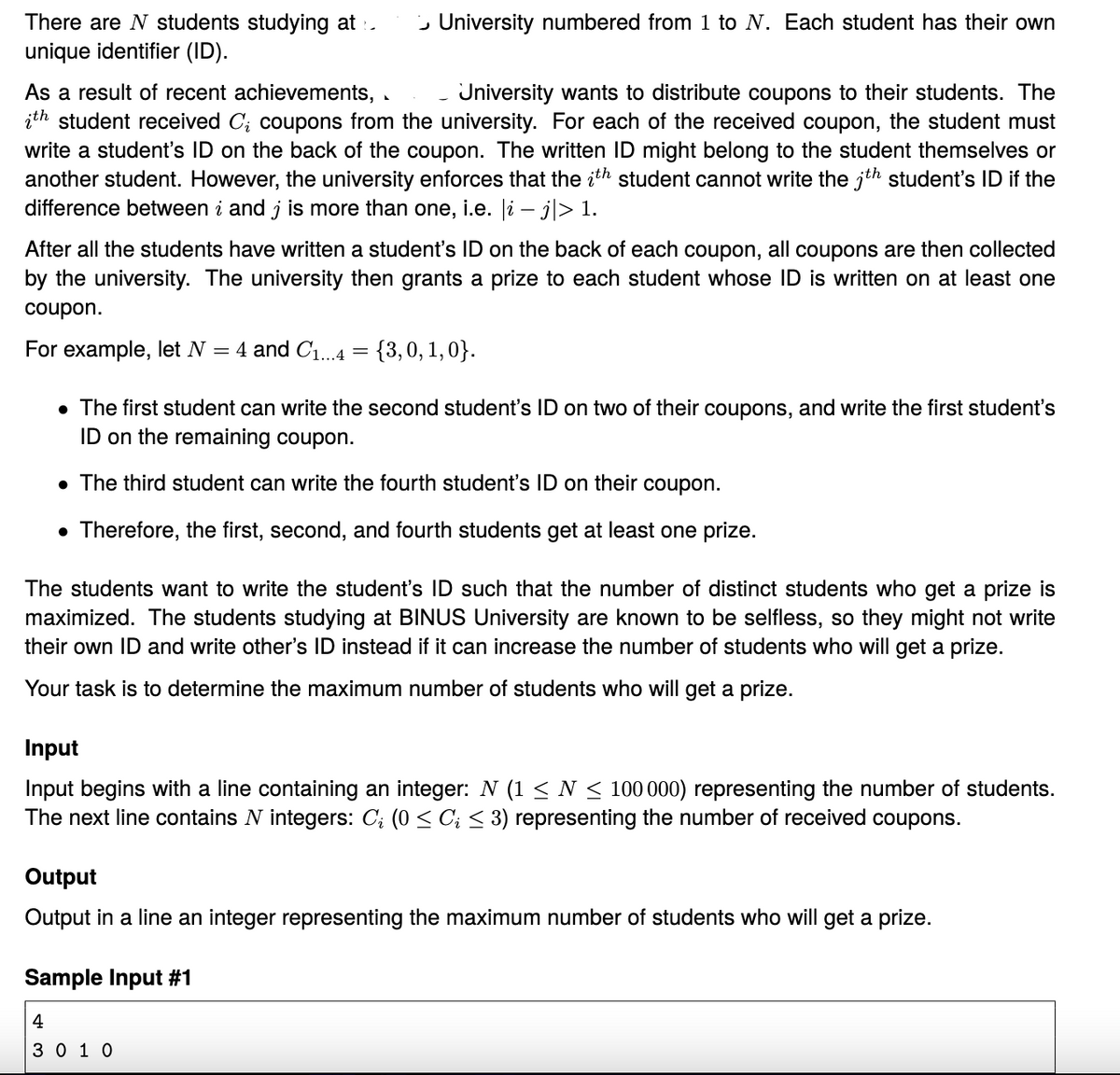There are N students studying at :. unique identifier (ID). University numbered from 1 to N. Each student has their own As a result of recent achievements, . ith student received C; coupons from the university. For each of the received coupon, the student must write a student's ID on the back of the coupon. The written ID might belong to the student themselves or another student. However, the university enforces that the ith student cannot write the jth student's ID if the difference between i and j is more than one, i.e. |i – j|> 1. Jniversity wants to distribute coupons to their students. The After all the students have written a student's ID on the back of each coupon, all coupons are then collected by the university. The university then grants a prize to each student whose ID is written on at least one coupon. For example, let N = 4 and C1.4 = {3,0, 1,0}. The first student can write the second student's ID on two of their coupons, and write the first student's ID on the remaining coupon. • The third student can write the fourth student's ID on their coupon. • Therefore, the first, second, and fourth students get at least one prize. The students want to write the student's ID such that the number of distinct students who get a prize is maximized. The students studying at BINUS University are known to be selfless, so they might not write their own ID and write other's ID instead if it can increase the number of students who will get a prize. Your task is to determine the maximum number of students who will get a prize.
There are N students studying at :. unique identifier (ID). University numbered from 1 to N. Each student has their own As a result of recent achievements, . ith student received C; coupons from the university. For each of the received coupon, the student must write a student's ID on the back of the coupon. The written ID might belong to the student themselves or another student. However, the university enforces that the ith student cannot write the jth student's ID if the difference between i and j is more than one, i.e. |i – j|> 1. Jniversity wants to distribute coupons to their students. The After all the students have written a student's ID on the back of each coupon, all coupons are then collected by the university. The university then grants a prize to each student whose ID is written on at least one coupon. For example, let N = 4 and C1.4 = {3,0, 1,0}. The first student can write the second student's ID on two of their coupons, and write the first student's ID on the remaining coupon. • The third student can write the fourth student's ID on their coupon. • Therefore, the first, second, and fourth students get at least one prize. The students want to write the student's ID such that the number of distinct students who get a prize is maximized. The students studying at BINUS University are known to be selfless, so they might not write their own ID and write other's ID instead if it can increase the number of students who will get a prize. Your task is to determine the maximum number of students who will get a prize.
Database System Concepts
7th Edition
ISBN:9780078022159
Author:Abraham Silberschatz Professor, Henry F. Korth, S. Sudarshan
Publisher:Abraham Silberschatz Professor, Henry F. Korth, S. Sudarshan
Chapter1: Introduction
Section: Chapter Questions
Problem 1PE
Related questions
Question
Only C/C++

Transcribed Image Text:Sample Output #1
3
Explanation for the sample input/output #1
This is the example from the problem description.
Sample Input #2
6
1 1 1 1 1 1
Sample Output #2
6.
Explanation for the sample input/output #2
Since each student received a coupon, they simply need to write their own ID on the back of their coupon.
Sample Input #3
6.
0 2 0 0 3 1
Sample Output # 3

Transcribed Image Text:There are N students studying at :.
, University numbered from 1 to N. Each student has their own
unique identifier (ID).
As a result of recent achievements, .
Jniversity wants to distribute coupons to their students. The
ith student received C; coupons from the university. For each of the received coupon, the student must
write a student's ID on the back of the coupon. The written ID might belong to the student themselves or
another student. However, the university enforces that the ith student cannot write the jth student's ID if the
difference between i and j is more than one, i.e. i – jl> 1.
After all the students have written a student's ID on the back of each coupon, all coupons are then collected
by the university. The university then grants a prize to each student whose ID is written on at least one
coupon.
For example, let N
= 4 and C1.4 = {3,0,1,0}.
• The first student can write the second student's ID on two of their coupons, and write the first student's
ID on the remaining coupon.
• The third student can write the fourth student's ID on their coupon.
• Therefore, the first, second, and fourth students get at least one prize.
The students want to write the student's ID such that the number of distinct students who get a prize is
maximized. The students studying at BINUS University are known to be selfless, so they might not write
their own ID and write other's ID instead if it can increase the number of students who will get a prize.
Your task is to determine the maximum number of students who will get a prize.
Input
Input begins with a line containing an integer: N (1 < N < 100000) representing the number of students.
The next line contains N integers: C; (0 < C; < 3) representing the number of received coupons.
Output
Output in a line an integer representing the maximum number of students who will get a prize.
Sample Input #1
4
3 0 1 0
Expert Solution
This question has been solved!
Explore an expertly crafted, step-by-step solution for a thorough understanding of key concepts.
This is a popular solution!
Trending now
This is a popular solution!
Step by step
Solved in 2 steps with 2 images

Knowledge Booster
Learn more about
Need a deep-dive on the concept behind this application? Look no further. Learn more about this topic, computer-science and related others by exploring similar questions and additional content below.Recommended textbooks for you

Database System Concepts
Computer Science
ISBN:
9780078022159
Author:
Abraham Silberschatz Professor, Henry F. Korth, S. Sudarshan
Publisher:
McGraw-Hill Education

Starting Out with Python (4th Edition)
Computer Science
ISBN:
9780134444321
Author:
Tony Gaddis
Publisher:
PEARSON

Digital Fundamentals (11th Edition)
Computer Science
ISBN:
9780132737968
Author:
Thomas L. Floyd
Publisher:
PEARSON

Database System Concepts
Computer Science
ISBN:
9780078022159
Author:
Abraham Silberschatz Professor, Henry F. Korth, S. Sudarshan
Publisher:
McGraw-Hill Education

Starting Out with Python (4th Edition)
Computer Science
ISBN:
9780134444321
Author:
Tony Gaddis
Publisher:
PEARSON

Digital Fundamentals (11th Edition)
Computer Science
ISBN:
9780132737968
Author:
Thomas L. Floyd
Publisher:
PEARSON

C How to Program (8th Edition)
Computer Science
ISBN:
9780133976892
Author:
Paul J. Deitel, Harvey Deitel
Publisher:
PEARSON

Database Systems: Design, Implementation, & Manag…
Computer Science
ISBN:
9781337627900
Author:
Carlos Coronel, Steven Morris
Publisher:
Cengage Learning

Programmable Logic Controllers
Computer Science
ISBN:
9780073373843
Author:
Frank D. Petruzella
Publisher:
McGraw-Hill Education